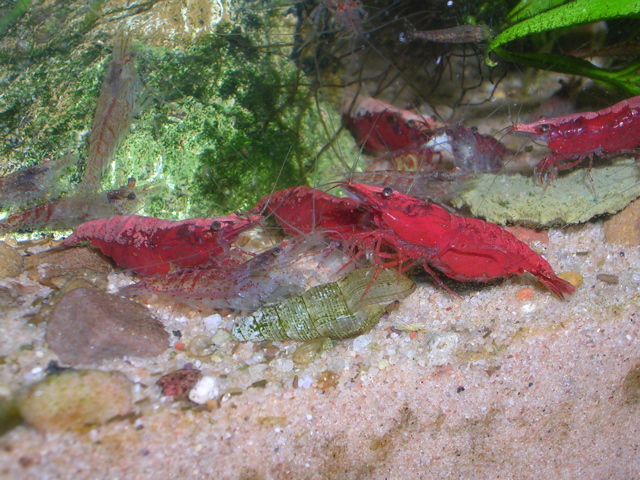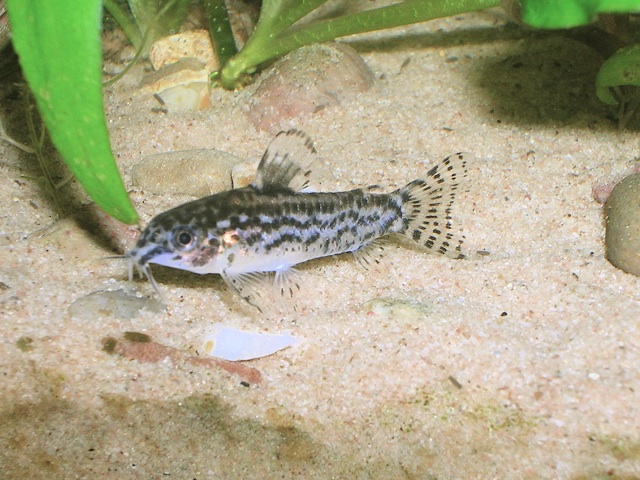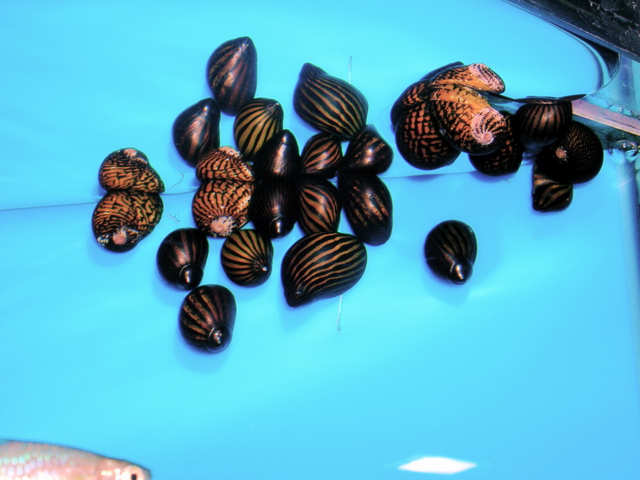|
|
Related Articles:
Stocking 5, 10 & 20
Gallon Freshwater Aquariums by Neale Monks,
Stocking a 10-gallon
aquarium: some new ideas and old favourites for nano tanks
by Neale Monks
Freshwater Livestock by Neale Monks,
Freshwater Livestock Selection by Bob Fenner,
The Ethical
Aquarist; Freshwater Fishes to Avoid by Judy Helfrich
Acclimation of New Freshwater Livestock by Bob Fenner,
Fishes,
Amphibians,
Turtles,
Related FAQs: FW Livestock 1,
FW Livestock 2, FW Livestock 3,
FW Stocking 4, FW Livestocking 5,
FW Livestocking 6,
FW Livestocking 7,
FW Livestocking 9,
FW Livestocking 10,
FW Livestocking 11,
& &
Freshwater Livestock Selection, Community
Tank Livestocking,
|
Stocking 5, 10 and 20 gallon
freshwater aquaria
|
By Neale Monks |
“The bigger the aquarium, the easier maintaining it will be.” This is
probably the single most important rule in the hobby, and for someone
setting up their first aquarium, it is an absolutely essential fact of
life. The size of the aquarium has a direct impact on several key
physical and chemical processes, including pH stability, thermal
stability, and the dilution of metabolic wastes such as ammonia. The
smaller the tank, the less stable and the more toxic the environment is
likely to be.
The size of the aquarium is also important in terms of how fish behave.
Schooling fish need to be kept in groups of at least five or six
specimens, and that it turn requires a certain amount of aquarium volume
and swimming space. When kept in insufficient numbers, barbs, Danios and
tetras become frustrated and often turn aggressive or nippy. Territorial
fish need to be able to claim a certain patch of ground, and if there
isn’t enough space in the tank, fighting or bullying can occur.
Livebearers pose a particular set of problems because of the way males
fight with each other while also tending to bully the females. It is
important that there is enough space for the male and female livebearers
to spread out, and if necessary find hiding places where they can rest
or give birth safely.
For all practical purposes, the minimum “safe” aquarium size is 20 US
gallons (75 litres). Such a tank will be big enough to accommodate a
reasonable selection of small aquarium fish without being particularly
large or expensive. More ambitious aquarists interested in big or
territorial species such as cichlids should consider larger systems
though, with tanks up to 55 US gallons (210 litres) in size providing a
good balance between size and expense.
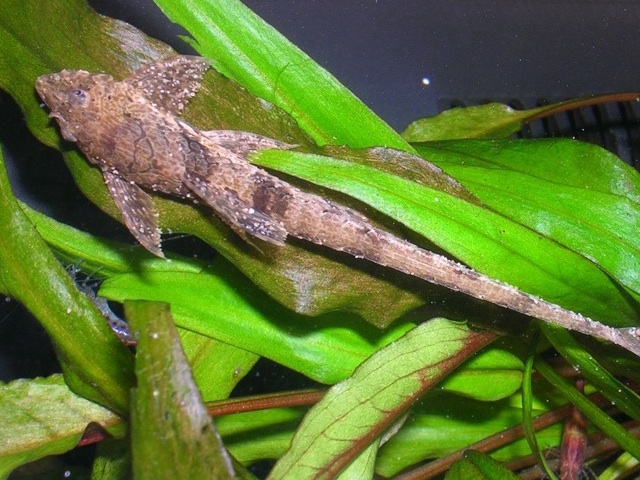
Why keep a small aquarium at all?
Small aquaria can be fun, and obviously they’re easier to fit into a
crowded apartment or dorm room. But let’s be clear about one reason
never to keep a small aquarium: to save money.
You won’t save money setting up a small aquarium. The price
differential between a 10-gallon tank and a 20-gallon tank is
trivially small, and the key pieces of equipment such as heaters and
filters will likely be the same anyway, so there’s no savings to be
had there. Decorating the two different tanks in terms of gravel,
bogwood and plants will be pretty much the same as well.
Running a small aquarium won’t save you any money either. Because a
small aquarium is more prone to problems, you’ll likely (almost
certainly) have to deal with things like Finrot, fungus and
Whitespot on a regular basis. Even after spending money on the
medications, if conditions are fundamentally poor or unstable, the
chances of the fish dying are much higher than in a bigger aquarium.
Dead fish will need to be replaced, and that costs money. Worst case
scenario, all your fish die and all your plants rot, so you give up
and abandon fishkeeping altogether. However seemingly inexpensive
your fish tank might have been, it’s a total waste of money if it
isn’t used.
So I say again, if you’re new to the hobby or want a simple, easy to
maintain aquarium, always choose a tank at least 20 gallons in size.
In the long term, this will be the economical as well as the easier
option
5-gallon (19 litre) tanks
Stocking tanks under 10-gallons in size is difficult because relatively
few fish can be maintained in such small environments permanently. Popular fish
like neons, guppies and Corydoras simply aren’t viable in 5-10 gallon
tanks. Your options are really limited to just two things: Bettas and freshwater
invertebrates.
Bettas (often called Siamese fighting fish) are domesticated varieties
of the species Betta splendens. The males have been bred to have
exceptionally long, colourful fins. They find it difficult to swim against
strong currents, and because of this tend to be rather lethargic animals. While
you can keep them in larger tanks if you want, male Bettas do perfectly well in
tanks as small as 5 gallons in size.
It isn’t a good idea to keep them in small containers though. Very small
tanks (or bowls) less than 5 gallons in size are difficult to heat and filter.
Bettas are not coldwater fish; they must be kept at around 26-28 degrees C
(79-82 degrees F) all day long. Putting an unheated Betta bowl below a light
bulb for a few hours isn’t an alternative! Similarly, you need to consider
filtration. An air-powered sponge filter works great in a 5-10 gallon aquarium
and will do a good job of removing ammonia. Bettas exposed to poor quality water
invariably become sick and die prematurely, often from completely avoidable
problems such as Finrot.
People who breed Bettas typically keep the males in bowls, even jam
jars, but what casual hobbyists don’t realise is that these bowls are kept in
heated fish rooms, and the water in the bowls is changed at least once a day.
That’s an insane amount of work for someone who just wants a pet fish: if you
want a Betta, invest in a 5-10 gallon tank, buy the heater, install a filter,
and enjoy your fish doing nothing more strenuous than replacing 25% of the water
weekly and periodically cleaning the filter as required.
The freshwater invertebrates most often kept in miniature aquaria are
the small algae-eating shrimps. Cherry shrimps, bumblebee shrimps, and crystal
red shrimps are a few examples of the pretty little shrimps available to the
aquarist. Most shrimps are gregarious, but some will also breed readily if
properly maintained. If you look after your shrimps, it is entirely possible
you’ll soon have quite a sizeable population of the things in your aquarium!
Because shrimps are brightly coloured and very active, they’re fun animals to
watch. Feel free to mix different varieties: they all seem to get along nicely.
Different species are red, orange, blue and all sorts of other colours, so
there’s plenty of scope for creating a busy little ‘freshwater nano reef tank’.
Shrimps tend to be quite hardy in some respects, being adaptable to a
range of temperatures and water chemistry conditions. Some shrimps come
from subtropical and warm temperate parts of the world such as Japan and
eastern China, and as such can be kept in unheated aquaria provided your
home doesn’t get too cold. Cherry shrimps for example will be quite
happy with wintertime temperatures as low as 15 degrees C (59 degrees
F). Most shrimps prefer neutral to alkaline conditions, and in general
you should avoid keeping them in conditions where the pH drops below
6.5. What all shrimps do demand is good water quality, so filtration is
essential. Alongside this it is important to remember shrimps, and
indeed invertebrates generally, are killed by copper-based medications
such as those used to treat Whitespot (ick).
Very small tanks tend to lack strong lighting, but you’ll be surprised
how well things like Anubias, Java fern and Java moss will do,
even at light intensity levels as low as 1 watt per gallon. Java moss in
particular works great with shrimps, giving newly hatched shrimps a
place to hide for the first few days when they are at their most
vulnerable.
10-gallon (38 litre) tanks
If I could, I’d make these tanks prescription-only! Ten gallon tanks
sound a great idea, but in practise they’re just too small to be useful
as general purpose community tanks. They’re great for rearing baby fish
or for maintaining breeding pairs of dwarf cichlids. But for your
standard issue mixed species community, these tanks are extremely
confining.
- Neon tetras, Paracheirodon innesi -
Ideally suited to small tanks thanks to their small size and relative
lack of activity. Mostly sit about under the plants looking nice.
Sociable; best kept in big groups, ideally ten or more specimens. Neons
have a mixed reputation, with many aquarists finding them very difficult
to maintain for more than a few months. There are a couple of things to
remember with neons. Firstly, they’re from relatively cool climates, so
don’t keep them any warmer than 75 degrees F (24 degrees C). Secondly,
they’re prone to something called Neon Tetra Disease, possibly two or
more completely different diseases. Whatever the causes, this disease is
highly contagious, so take care never to buy neons from a tank where you
can already see sickly, poorly coloured, or dead specimens.
- Cardinal tetras, Paracheirodon axelrodi -
Another great species for the smaller tank. Slightly larger than the
neon and with a bit more red, but otherwise similar in appearance and
requirements. Does need warmer water though, ideally 78-80 degrees F
(26-28 degrees C). Marginally fussier about water chemistry too, and do
best in soft, slightly acidic conditions. Less prone to disease though,
and in mature tanks can be considered reasonably easy to keep.
- Glowlight tetra, Hemigrammus erythrozonus -
An old favourite, this small, transparent fish has a lovely copper band
along the body. Keep in groups of six or more specimens. Looks great in
shady, well-planted tanks. Essentially hardy and easy to keep.
- Golden (or Beckford’s) Pencilfish, Nannostomus beckfordi
- Pencilfish are mostly delicate and difficult to keep, but the
golden Pencilfish is surprisingly adaptable and does very well in quiet
community tanks. Mixes well with small tetras, dwarf Corydoras
and so on. Keep in groups of at least six specimens. Unlike most other
Pencilfish, this species does well in flake foods.
- Galaxy Rasbora, Celestichthys margaritatus -
Newly discovered and first imported from Burma in 2006. Tank-bred stock
is now widely sold and recommended for aquarists after small, colourful
schooling fish. Prefers neutral to slightly basic, moderately hard
water. Temperature is critical: keep them no warmer than 75 degrees F
(24 degrees C).
-
Kuhli loach, Pangio spp -
These colourful characters are very peaceful and easy to keep,
though being rather shy and nocturnal don’t expect to see that much
of them! Numerous species, ranging up to about 4 inches (10 cm) in
length. Gregarious; keep in groups of five or more specimens. Water
chemistry not critical, but these fish are notorious escape artists,
so are not suitable for uncovered tanks.
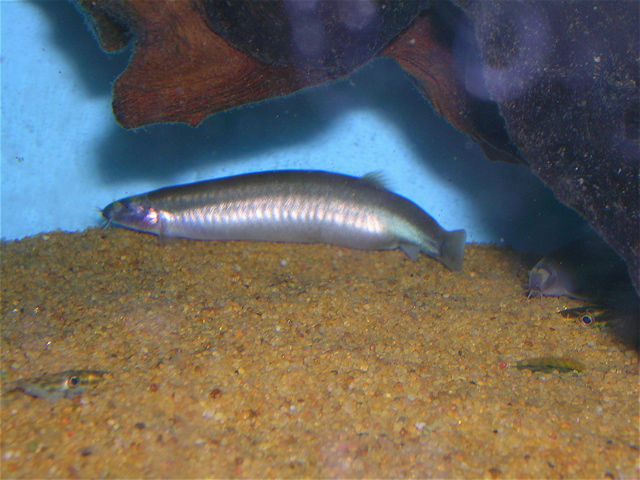
- Whiptail catfish, Hemiloricaria spp -
Getting to around 4 inches (10 cm) in length, these unusual catfish are
relatively inactive and cannot swim well. They prefer to amble about on
a sandy substrate, rooting about for food. Easy to maintain on algae
wafers, bloodworms and catfish pellets. Keep singly or in groups.
Harmless oddballs ideally suited to small tanks.
- Dwarf Corydoras, Corydoras habrosus and
Corydoras hastatus - These little catfish are gregarious
and should be maintained much like regular Corydoras. Keep in
groups of six or more specimens, and feed them with tiny catfish
pellets, frozen bloodworms and other small foods. When happy, these
catfish are very active and like to swim about in midwater.
- Sparkling Gourami, Trichopsis pumila - One
of the smallest labyrinth fish and an ideal addition to a densely
planted community tank. Peaceful and easy to maintain. Do not combine
with larger fish though, and keep away from anything aggressive or
nippy.
- Chameleonfish, Badis and Dario spp -
Not easy fish to maintain, but brilliantly coloured. Must have live or
wet frozen (not freeze dried) foods such as bloodworms and daphnia. Will
not eat flake or pellets. Keep in a planted tank with quiet tankmates.
Water chemistry not critical.
- Shell dwellers, Neolamprologus spp - There
are various dwarf cichlids from Lake Tanganyika that inhabit empty snail
shells. These cichlids are territorial but don’t stray far from their
home shells, so managing them is quite easy. Neolamprologus brevis
is a popular species recommended for beginners. Like all Tanganyikan
cichlids it is sensitive to poor water quality and must be kept in hard,
alkaline conditions. Colonies are best kept on their own, though some
aquarists combine them with small, surface dwelling livebearers such as
dwarf Mosquitofish.
- Peacock goby, Tateurndina ocellicauda -
These small gobies are beautifully marked with yellow, purple and red
spots. They are easy to maintain on live and wet frozen foods, but have
no interest at all in freeze-dried or flake foods. Males and females are
similar, but the males have a stockier profile (especially around the
head) and spend much of the time guarding their caves. Will spawn
readily in a peaceful aquarium.
- Algae shrimps, Caridina and Neocaridina -
Numerous shrimp species are available, but the small algae-eating
species from Asia are particularly useful in small tanks. They are
active, often colourful, and in some cases breed readily.
20-gallon (76 litre) tanks
Tanks this size are ideal starting points for anyone entering the hobby.
In the United States 20-gallon tanks are available in “tall” and “long”
varieties. The tall tanks measure roughly 24 inches in length and 17
inches in depth; the long tanks are 30 inches in length and 13 inches in
depth. All else being equal, the long tank is better. Long tanks offer
more swimming space and have a greater surface area to volume ratio,
meaning oxygen diffuses into the tank at a faster rate. You can keep
more fish, more happily, in a long tank than a tall tank.
Do tall 20-gallon tanks have any advantages? Not many. They are perhaps
a bit easier to decorate with tall plants and rocks, and having a
smaller footprint they take up less space on a tabletop or shelf.
Greater depth does work better with certain small but tall fish, in
particular domesticated angelfish. But beyond that, these tanks are far
inferior to long tanks for general fishkeeping and are best avoided by
less experienced hobbyists.
Species useful in 10-gallon tanks will do even better in a 20-gallon tank.
In the case of things like small tetras, you can keep larger groups. If
you have a nicely planted aquarium, consider keeping two dozen neons for
example. Otherwise some of the additional species you can sensibly keep
in a 20-gallon tank include the following:
- Zebra and pearl Danios, Danio rerio and Danio
albolineatus - Despite being only a couple of inches (5
cm) in length, these small Danios are far too active to be happy in a
10-gallon tank. But in a long 20-gallon aquarium these fish are
wonderful, providing plenty of colour and activity. Keep in schools of
six or more: in smaller groups, these fish can become nippy. They are
also prone to bullying small surface-dwelling fish like White Cloud
mountain minnows and fancy guppies, so are best kept with midwater and
bottom feeding tankmates. Danios are adaptable fish and generally live
for a long time if provided with decent basic care; the main thing to
remember is that they are Hillstream fish that don’t like temperatures
above 77 degrees F (25 degrees C).
- Glowlight Danio, Danio choprae - Much like
the zebra Danio in requirements, these small Danios do well in 20-gallon
tanks. Increasingly widely sold, these elegant fish are beautifully
marked with copper and blue markings on the flanks.
- Tiger barb, Puntius pentazona - These
colourful fish have been popular for decades, and are essentially hardy,
low-maintenance animals. They are distinctly sociable though, so keep at
least six. In smaller groups they tend to become bored and consequently
nippy, attacking anything that can’t easily swim away. Angelfish,
gouramis and guppies are easy targets. Albino and moss barbs are the
same species as the tiger barb, and the ruby barb, Puntius
nigrofasciatus, though distinct, requires similar care.
- Harlequin Rasbora, Trigonostigma heteromorpha -
An excellent schooling fish for the 20-gallon tank, but fussy about
water chemistry. Not recommended for aquarists in hardwater areas;
generally does best in soft, slightly acidic conditions. Prefers a
planted tank with lots of shade.
-
Guppies and platies, Poecilia and
Xiphophorus spp - These livebearers are
sometimes kept in smaller tanks, but the males are aggressive and
can become bullies. In larger tanks, they are more easily maintained
in groups of one male to every two females. Stock the tank with
floating plants if you want to collect any baby fish before the
other fish eat them!
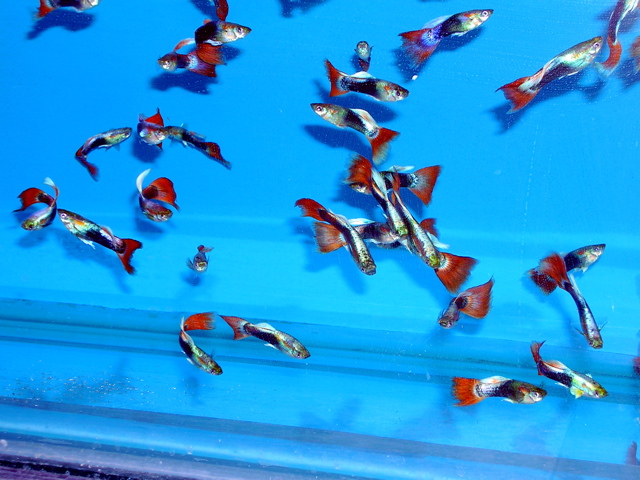
- Corydoras - As noted
earlier, the dwarf species can be kept in smaller tanks, but most of the
popular species such as peppered, bronze and panda Corydoras do
best in a 20-gallon tank. Keep them in groups of five or more specimens.
Corydoras are generally undemanding, though to avoid keeping them
too warm; most species prefer temperatures around 75 degrees F (24
degrees C).
- Dwarf upside-down catfish, Synodontis nigriventris
- Gregarious and very hardy catfish; recommended for aquarists
interested in oddball catfish. Keep in groups of three or more
specimens. Sometimes a fin-nibbler, so best not mixed with fancy
guppies, Bettas, and other slow-moving fish. Very nocturnal!
- Bristlenose catfish, Ancistrus spp - This
is one of the best catfish for the smaller aquarium. Maximum length is
about 5 inches (12 cm). Although secretive and essentially nocturnal,
this catfish is a good algae-eater and basically easy to keep. Make sure
it gets regular feedings of green foods and algae wafers.
- Dwarf Rainbowfish, Melanotaenia praecox -
A superb schooling fish with a silvery-blue body and pink fins. Maximum
length is 2.5 inches (6 cm). As with other Rainbowfish, keep in groups
of six or more specimens.
- Bolivian ram, Mikrogeophagus altispinosus -
Unlike the delicate and disease-prone common ram cichlid
Mikrogeophagus ramirezi, the Bolivian ram is hardy and easily
maintained in community tanks. Highly recommended as a “first cichlid”
for the less experienced hobbyist.
- Kribs, Pelvicachromis spp - The common
Krib is Pelvicachromis pulcher but there are other species
available including Pelvicachromis taeniatus and
Pelvicachromis subocellatus all are similar in size and habits.
Kribs are territorial, so should be given a cave, hollow ornament or
flowerpot that they can defend without disrupting the whole tank.
Generally work best with midwater and upper level fish.
- Thick-lipped and banded gouramis, Colisa labiosus
and Colisa fasciata - Two small gouramis noted for
their bluish body colouration and oblique brick red stripes. Broadly
similar to the more widely traded dwarf Gourami, but slightly larger at
3-4 inches (7.5-10 cm) in length. Very hardy and easy to maintain, these
are ideal gouramis for small aquaria.
- Dwarf Gourami, Colisa lalia - Various
forms exist, including neon gouramis, sunset gouramis, powder blue
gouramis and so on. Widely traded but the farmed stock from Southeast
Asia especially is extremely prone to a viral disease that is highly
contagious, invariably fatal, but currently untreatable. Best avoided
unless you have access to locally bred fish.
- Domesticated angelfish, Pterophyllum hybrid -
The standard angelfish of the hobby are hybrids that usually get to no
more than 4 inches (10 cm) in length. They are quite tall though, so are
amongst those fish particularly well suited to “tall” 20-gallon tanks.
They do of course look better in larger tanks, but singletons or pairs
can be maintained in 20-gallon tanks without problems. Do note however
that angelfish are territorial, and they are also predatory, and will
eat very small fish such as neons.
Common community fish unsuitable for small aquaria
Having looked at some fish that make good choices for small tanks, let’s
review some of the most widely traded and popular fish that would make
bad choices for small tanks. In most cases sheer size is the issue: most
anything above a couple of inches (5 cm) in length is likely to find a
small aquarium too confining. Large fish make a lot of mess as well, and
that will mean that maintaining good water quality will be much more
difficult. Ensuring water chemistry stability will be difficult too. The
following are fish that will require a tank at least 30 gallons (115
litres) in size, and in many cases significantly more.
- Mollies, Poecilia spp - Although popular
fish and very colourful, mollies are exceptionally sensitive to poor
water quality and pH instability. They invariably do best in spacious,
well filtered, slightly brackish conditions. Males also tend to be quite
aggressive towards one another, and frequently pester the females as
well. An aquarium at least 30 gallons (115 litres) in size is
recommended for mollies.
- Swordtail, Xiphophorus hellerii -
Swordtails are hyperactive fish adapted to rivers and fast-flowing
streams. They need lots of swimming space. Males are notoriously
aggressive, and in small aquaria can become bullies. Consider 30 gallons
(115 litres) the minimum safe size for swordtails.
- Otos, Otocinclus spp - Despite their tiny
size, these dwarf suckermouth catfish are extremely difficult to
maintain for any length of time in anything less than ideal conditions.
Specifically, they need soft, slightly acidic water that is not too
warm; aim for pH 6.5, 10 degrees dH or less, and a temperature no higher
than 75 degrees F (24 degrees C). They also need perfect water quality,
and do best in tanks with vigorous filtration. Because they feed almost
entirely on algae, they should never be put in small or young tanks that
lack the requisite healthy fuzz of green algae in the rocks and plants:
realistically, this means keeping them in tanks at least three months
old and not less than 30 gallons (115 litres) in size. Finally, these
are schooling fish, and should only be kept in groups of at least six
specimens. Expert aquarists might well be able to maintain a school of
Otocinclus in smaller tanks by offering appropriate foods and
monitoring water conditions carefully, but causal aquarists would do
best to ignore these tiny catfish in favour of hardier species like
Bristlenose cats and Corydoras.
- Silver dollars, Metynnis and Myleus spp -
Various silver dollars are traded, but most get to at least 4 inches (10
cm) in length. They are active, schooling fish that tend to be nervous
when kept in insufficient numbers. Best reserved for community tanks 55
gallons (210 litres) or larger.
- Goldfish, Carassius auratus - Goldfish are
essentially pond fish, and need as much space as you can give them. If
you’re going to keep goldfish indoors, don’t waste your time or money on
anything less than a 30 gallon systems (115 litre) system: anything
smaller is unlikely to maintain them in good health. Under poor
conditions goldfish are prone to Finrot, fungal infections and all sorts
of other opportunistic infections.
- Non-dwarf Australian Rainbowfish, Melanotaenia spp
- Wonderful fish in many ways, these fish are active and get
quite large, typically 4-6 inches (10-15 cm) so require much more space
than a 20-gallon tank can provide. The smaller species work well in 30
gallon systems; larger species look their best in tanks upwards of 55
gallons (210 litres).
- Silver shark, Balantiocheilos melanopterus -
A big, schooling barb-like fish that needs plenty of swimming space.
Should be kept in groups of at least five specimens. Maximum size is 14
inches (35 cm) though aquarium specimens tend to be slightly smaller,
8-10 inches (20-25 cm) being typical. Nervous and jumpy, does not do
well when “cramped”. Consider a tank 55 gallons (210 litres) in size the
absolute minimum, and the bigger the tank, the better.
- Three-spot (blue, gold, Opaline) Gourami, Trichogaster
trichopterus - Although hardy and adaptable, males of this
species are distinctly aggressive and frequently become bullies in small
tanks. Females may make acceptable additions to tanks as small as 20
gallons (75 litres), but males should be reserved for systems 30 gallons
(115 litres) in size or larger.
- Cichlids, family Cichlidae - Apart from some of the
dwarf species already mentioned, cichlids tend to be too aggressive and
territorial for use in small tanks, even if their body size seems
manageable. When spawning, cichlids can be dangerously violent!
- Kissing Gourami, Helostoma temminckii -
Not particularly aggressive, but large and sensitive to poor
environmental conditions. Maximum size is around 12 inches (30 cm)
though aquarium specimens are typically only about 8 inches (20 cm) in
length. A reasonably good community fish in systems upwards of 55
gallons (210 litres).
- Clown loach, Chromobotia macracanthus -
Clown loaches are big, gregarious fish that tend to be fairly boisterous
as well. They should be kept in groups, ideally in schools of at least
five specimens. Maximum size is around 12 inches (30 cm) though most
specimens only get to about one-half to two-thirds that size.
Regardless, their sheer size makes them unsuitable for small tanks. They
also need good water quality and plenty of water movement, so a big,
generously filtered aquarium is essential. Not suitable for anything
less than 55 gallons (210 litres), and realistically 75 gallons (280
litres) is a much better bet.
- Common Plec, Pterygoplichthys spp - The
default algae-eating catfish; hardy, peaceful, widely sold and very
inexpensive. But approach this fish with caution! Routinely gets to a
length of 12 inches (30 cm) and potentially significantly more. Because
of its size and herbivorous nature this fish creates a lot of mess. A
big, well-filtered tank is essential. Unsuitable for any aquarium
smaller than 55 gallons (210 litres).
- Algae eater or sucking loach, Gyrinocheilus aymonieri
- Another widely traded algae-eating fish. Juveniles may seem
attractive, but quickly grow into highly territorial, aggressive adults
around 10-12 inches (25-30 cm) in length. Not really suited to community
tanks at all, and even in rough-and-tumble systems should not be kept in
anything less than 55 gallons (210 litres) in size.
|
|

